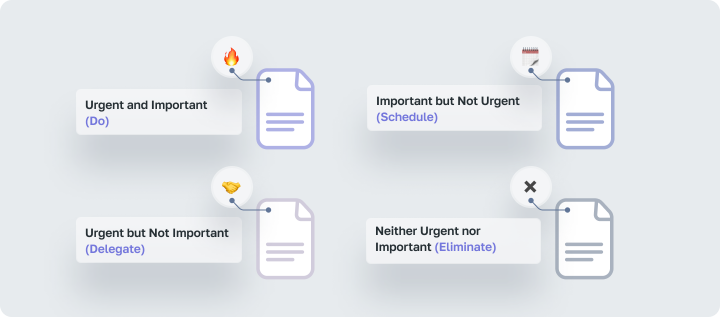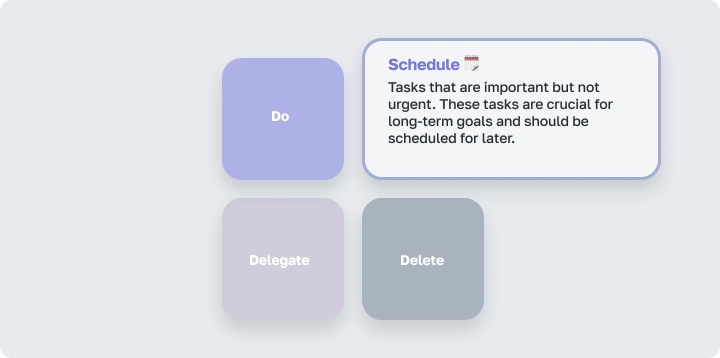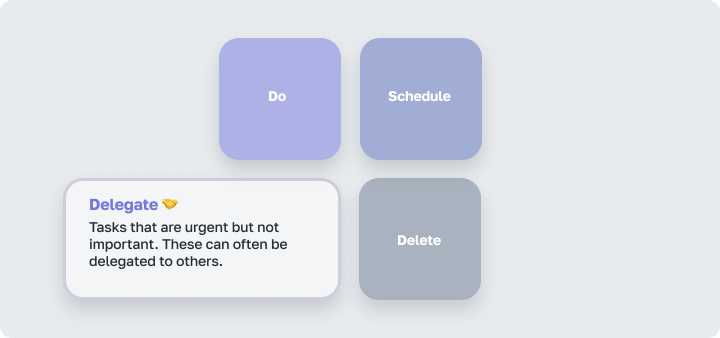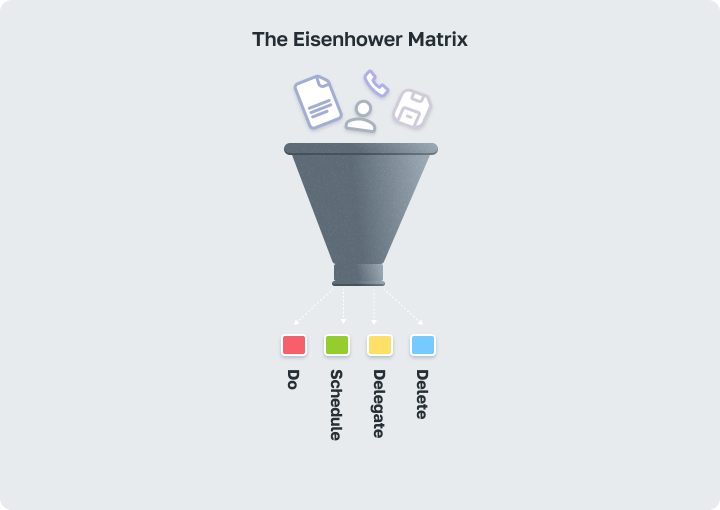Introduction to the Eisenhower Matrix
The Eisenhower Matrix offers a transformative approach to prioritizing and managing time. Based on the principles of Dwight D. Eisenhower, this strategic tool simplifies organizing tasks by categorizing them according to urgency and importance, facilitating a more focused and effective method of managing multiple responsibilities.
As a versatile framework, the Eisenhower Decision Matrix goes beyond mere methodology. It provides a robust mechanism for improved decision-making in today’s dynamic work environment. It serves as a navigational aid that enables professionals to identify and prioritize assignments that are critical for immediate execution, as well as those that are critical for long-term success.
Understanding the Eisenhower Matrix
The Concept and Origin of the Eisenhower Matrix
This time management tool is rooted in the principles of Dwight D. Eisenhower. During his presidency, Eisenhower was known for his exceptional ability to manage tasks.
The Eisenhower Priority Matrix is underpinned by Eisenhower’s principle: “What is important is seldom urgent, and what is urgent is seldom important”. This insight into the nature of tasks and priorities forms the backbone of the Eisenhower Matrix, guiding its structure and application. The Eisenhower Method of time management simplifies decision-making by categorizing tasks into four quadrants based on urgency and importance.
The Eisenhower Matrix is divided into four quadrants, each representing a specific category of assignments:

- Urgent and Important (Do): Tasks that require immediate attention.
- Important but Not Urgent (Schedule): Tasks that are crucial for long-term success but do not require immediate action.
- Urgent but Not Important (Delegate): Tasks that need to be done soon but can be handled by others.
- Neither Urgent nor Important (Eliminate): Tasks that provide little or no value and should be eliminated from your schedule.
Urgent vs. Important: Distinguishing Task Priority
Understanding the difference between urgency and importance is key to using the Eisenhower Matrix effectively. Urgency refers to tasks that require immediate attention, often in the context of meeting the needs of others. In contrast, importance refers to tasks that contribute to long-term goals and values. This distinction allows professionals to allocate their time and resources more effectively and focus on what really matters.
By applying the Eisenhower Matrix, professionals can navigate their daily tasks with greater clarity, ensuring that their efforts are directed toward activities that significantly impact their goals and objectives. This strategic approach not only increases productivity, but also paves the way for a more balanced, fulfilling professional life.
Exploring the Four Quadrants of the Eisenhower Matrix
Quadrant  : Urgent and Important (Do)
: Urgent and Important (Do)
Tasks that fall into this Eisenhower matrix quadrant are both urgent and important. They require immediate attention due to their time-sensitive nature and significant impact on current projects or goals. Examples include crisis management, deadline-driven tasks, or unforeseen issues that require immediate resolution.

Strategies for dealing with Eisenhower matrix Quadrant I tasks:
- Prioritize these tasks above all others.
- Allocate uninterrupted blocks of time to efficiently complete these tasks.
- Use time management techniques, such as the Pomodoro Technique, to maintain focus and productivity.
- Periodically review project plans and workflows to prevent important tasks from becoming urgent, thereby reducing the frequency of Quadrant I tasks.
Quadrant  : Important but Not Urgent (Schedule)
: Important but Not Urgent (Schedule)
Eisenhower Matrix quadrant II tasks are important but not urgent. These tasks are critical to achieving long-term goals and include strategic planning, research and development, or relationship building.

Effectively schedule Eisenhower time management:
- Designate specific times in your schedule for these tasks to ensure they get the attention they deserve.
- Use project management tools to set reminders and deadlines for these tasks to keep them from slipping into urgency.
- Regularly review and adjust your long-term plans to incorporate these tasks and ensure they are aligned with your strategic goals
Quadrant  : Urgent but Not Important (Delegate)
: Urgent but Not Important (Delegate)
Tasks in this quadrant are urgent but not important to your own goals. They may be important to someone else’s goals, or they may require immediate attention, but they don’t contribute directly to your long-term goals.

Delegation concepts:
- Identify tasks that can be handled efficiently by other team members or external partners.
- Select delegates based on their skills, workload, and development needs.
- Clearly communicate expectations, deadlines, and any necessary background information to ensure successful task completion.
- Follow up with delegates regularly to monitor progress and provide support as needed.
Quadrant  : Neither Urgent nor Important (Delete)
: Neither Urgent nor Important (Delete)
Eisenhower Matrix Quadrant IV includes tasks that are neither urgent nor important. These are activities that provide little to no value and can distract from more productive efforts.

Importance of Eliminating Unnecessary Tasks:
- Regularly review your to-do list and project plans to identify and eliminate these tasks.
- Learn to say no to tasks that do not align with your strategic goals or contribute to productivity.
- Use this quadrant as a filter to eliminate clutter in your workflow, freeing up space and energy for Quadrant I and II tasks.
Practical Tips for Prioritizing Tasks Using the Eisenhower Matrix
By incorporating these practical tips into your use of the Eisenhower Matrix, you can further refine your task prioritization skills. Remember, the key to successful task management is not just working harder but working smarter, and these strategies are designed to help you do just that
 Implementing Color-Coding for Task Management
Implementing Color-Coding for Task Management
Visual cues can significantly enhance the process of task management. By implementing color-coding, you can quickly discern the urgency and importance of tasks at a glance. Assign specific colors to each quadrant of the Eisenhower Matrix.
For example:
 — red for urgent and important tasks (Quadrant I);
— red for urgent and important tasks (Quadrant I); — green for important but not urgent tasks (Quadrant II);
— green for important but not urgent tasks (Quadrant II);  — yellow for urgent but not important tasks (Quadrant III);
— yellow for urgent but not important tasks (Quadrant III); — blue for neither urgent nor important tasks (Quadrant IV).
— blue for neither urgent nor important tasks (Quadrant IV).
Here is how to easily implement color-coding for quadrant of the Eisenhower Matrix in Worksection using labels:

Worksection labels
This visual strategy simplifies the process of identifying which tasks require immediate attention and which can be scheduled or delegated.
 Limiting the Number of Tasks per Quadrant
Limiting the Number of Tasks per Quadrant
To maintain focus and efficiency, it’s critical to limit the number of tasks within each Eisenhower Matrix quadrant. An overloaded quadrant can lead to overwhelm and reduced productivity. Aim for a manageable number of assignments per quadrant, ideally no more than five to seven. This limitation encourages you to evaluate the true priority of each task and keeps your to-do list concise and actionable.
Manage your workload visually in Worksection with Kanban view:

Worksection Kanban
 Balancing Personal and Professional Tasks
Balancing Personal and Professional Tasks
Balancing both personal and professional tasks is essential to effective task management. Separate your tasks into two distinct categories within the Eisenhower Box: personal tasks and professional tasks.
Separating them helps ensure that each gets adequate attention and prevents one from overshadowing the other. It’s also a step toward achieving a better work-life balance, reducing stress, and increasing overall productivity.
 The Strategy of Elimination Before Prioritization
The Strategy of Elimination Before Prioritization
Adopt an elimination strategy before you dive into task prioritization. Review your tasks. Eliminate those that are not aligned with your goals or that have become irrelevant. This step reduces clutter in your task list, making it easier to focus on what really matters.
Once the list is reduced, you will be able to prioritize the remaining tasks more effectively and focus your energy and resources on the assignments that are truly important and urgent.
Illustrative Example of the Eisenhower Matrix in Action
Consider a mid-sized software development Company N facing the challenge of balancing a rigorous product development schedule with ongoing client support tasks. The Eisenhower Matrix is becoming an essential tool for the company’s project management team to help them effectively manage these responsibilities.
Eisenhower Matrix Quadrant I: Do
Company N is about to release a major update to its flagship product, but a critical vulnerability is discovered. Addressing this issue is both urgent and important to prevent potential security risks to their customers. The project management team prioritizes this task and allocates immediate resources for a quick fix.
Eisenhower Matrix Quadrant II: Schedule
Along with immediate concerns, the team plans a series of customer engagement sessions to gather feedback on new features for future updates. This task is critical to long-term product development, but not urgent given the upcoming release. It’s placed in Quadrant II, with sessions scheduled for the following quarter to allow for thorough preparation and customer outreach.
Eisenhower Matrix Quadrant III: Delegate
As the release date approaches, the demand for regular project status updates from internal stakeholders increases. While timely updates are urgent, producing detailed reports is not the best use of the project managers’ time. The team decides to delegate this task to a junior project coordinator, ensuring that stakeholders are kept informed without diverting key resources from critical project work.
Eisenhower Matrix Quadrant IV: Delete
During this time, the team receives numerous invitations to attend industry webinars and general company meetings. While these may provide long-term value, they are neither urgent nor critical to the success of the current project. Recognizing the need to focus on immediate project goals, the team politely declines these invitations, freeing up valuable time for project-critical activities.
By distinguishing between urgent and important tasks, delegating effectively, and eliminating distractions, the team can focus on what is critical to project success and business growth. This approach supports strategic planning and resource allocation for future initiatives, in addition to ensuring successful completion of immediate projects.
Eisenhower Matrix Usability:
Worksection’s Case
I consider Eisenhower matrix an ideal tool for managers’ daily use.
Vladyslav Radziievsky, CMO Worksection
How do you use the Eisenhower Matrix in your work?
I use the Eisenhower Matrix on a daily basis. For me, it is a key tool for prioritizing tasks and delegating.
Here’s how it works:
A task comes up, then I assess the level of importance and the deadline. If I can’t delegate that task, I place it in sector #1, “Important and Urgent. I perform tasks from this area myself and delegate all others. I also usually try not to keep tasks in sectors 1 and 4.

This allows me to have up to 10 new tasks per day. Using the Matrix, I can easily analyze their actual weight”, which greatly simplifies organizing the workflow.
And what about sector 4: Not Important and Not Urgent?
For me, these are tasks that are not completed because they need refining: lacking clear requirements, insufficient source data, etc. If a task is in sector 4, it means that it is not fully formulated. Once this task has been completed, it will fall into one of the other three sectors.
Leveraging Task Management Tools
to Build Your Eisenhower Matrix
Worksection extends the value of the Eisenhower Matrix by enabling a direct approach from task categorization to actionable management. Its comprehensive suite of tools ensures that tasks are not only categorized, but effectively managed, aligning daily efforts with long-term project goals and personal productivity strategies.

Worksection project dashboard
Eisenhower Matrix Quadrant 1: Important and Urgent
Tasks that require immediate attention. Worksection’s real-time notification and due date tracking capabilities help managers quickly identify, assign and ensure completion of these critical tasks.
Eisenhower Matrix Quadrant 2: Important but Not Urgent
Focused on long-term goals and projects, Worksection helps schedule these tasks, set milestones, and track progress to ensure consistent progress toward overall goals.
Eisenhower Matrix Quadrant 3: Urgent but not critical
These tasks seem urgent, but are less critical. Worksection’s delegation capabilities and communication tools help manage these tasks efficiently and prevent them from overwhelming higher priorities.
Eisenhower Matrix Quadrant 4: Not Important and Not Urgent
Activities that provide minimal value. Worksection’s analytics tools enable managers to assess and minimize the time spent on these tasks, optimizing workflow for more impactful activities.
In summary, Worksection’s integration with the Eisenhower Chart provides project managers with a refined method for prioritizing tasks and focusing efforts on what really matters for project success and personal efficiency.
Conclusion
We’ve explored a powerful framework for prioritizing tasks and managing time more effectively in this exploration of the Eisenhower Matrix. Here’s a quick recap and a forward-looking perspective on its role in project management:
Summary of Key Points
- Urgency vs. Importance: The Eisenhower Matrix distinguishes tasks based on their urgency and importance, providing a simple yet profound strategy for prioritization.
- Quadrant Analysis: Each of the four Eisenhower Matrix quadrants represents a specific category of task and guides users in deciding whether to complete, delegate, schedule, or delete tasks.
- Increased productivity: Through the use of the Eisenhower Matrix, professionals can increase productivity, reduce stress, and ensure that they are focusing on tasks that are truly critical to their goals and business objectives.
- Adaptable framework: While the Eisenhower Matrix is a powerful tool in its own right, its true strength lies in its adaptability. It can be customized to fit different workflows and integrated with other project management tools and methodologies.
In conclusion, the Eisenhower Matrix for time management is a testament to the enduring relevance of clear, strategic task prioritization in achieving professional and organizational success. As project management tools and methodologies continue to evolve, the fundamental principles of the Eisenhower Matrix will continue to be relevant and will guide professionals as they navigate the complexities of the modern workplace with confidence and clarity.